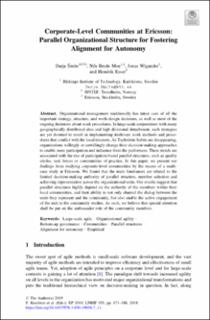| dc.contributor.author | Šmite, Darja | |
| dc.contributor.author | Moe, Nils Brede | |
| dc.contributor.author | Wigander, Jonas | |
| dc.contributor.author | Esser, Hendrik | |
| dc.date.accessioned | 2022-05-05T08:36:16Z | |
| dc.date.available | 2022-05-05T08:36:16Z | |
| dc.date.created | 2019-06-18T10:02:56Z | |
| dc.date.issued | 2019 | |
| dc.identifier.citation | Agile Processes in Software Engineering and Extreme Programming: 20th International Conference, XP 2019, Montréal, QC, Canada, May 21–25, 2019, Proceedings. Lecture Notes in Business Information Processing, 355, 173-188. | en_US |
| dc.identifier.issn | 1865-1348 | |
| dc.identifier.uri | https://hdl.handle.net/11250/2994307 | |
| dc.description.abstract | Organizational management traditionally has taken care of all the important strategy, structure, and work-design decisions, as well as most of the ongoing decisions about work procedures. In large-scale corporations with many geographically distributed sites and high divisional detachment, such strategies are yet doomed to result in implementing irrelevant work methods and procedures that conflict with the local interests. As Tayloristic habits are disappearing, organizations willingly or unwillingly change their decision-making approaches to enable more participation and influence from the performers. These trends are associated with the rise of participation-based parallel structures, such as quality circles, task forces or communities of practice. In this paper, we present our findings from studying corporate-level communities by the means of a multi-case study at Ericsson. We found that the main hindrances are related to the limited decision-making authority of parallel structure, member selection and achieving representation across the organizational units. Our results suggest that parallel structures highly depend on the authority of the members within their local communities, and their ability to not only channel the dialog between the units they represent and the community, but also enable the active engagement of the unit in the community studies. As such, we believe that special attention shall be put on the ambassador role of the community members. | en_US |
| dc.language.iso | eng | en_US |
| dc.rights | Navngivelse 4.0 Internasjonal | * |
| dc.rights.uri | http://creativecommons.org/licenses/by/4.0/deed.no | * |
| dc.subject | Large-scale agile | en_US |
| dc.subject | Organizational agility | en_US |
| dc.subject | Bottom-up governance | en_US |
| dc.subject | Communities | en_US |
| dc.subject | Parallel structures | en_US |
| dc.subject | Alignment for autonomy | en_US |
| dc.subject | Empirical | en_US |
| dc.title | Corporate-level communities at Ericsson: Parallel organizational structure for fostering alignment for autonomy | en_US |
| dc.title.alternative | Corporate-level communities at Ericsson: Parallel organizational structure for fostering alignment for autonomy | en_US |
| dc.type | Peer reviewed | en_US |
| dc.type | Journal article | en_US |
| dc.description.version | publishedVersion | en_US |
| dc.rights.holder | © The Author(s) 2019. | en_US |
| dc.source.pagenumber | 173-188 | en_US |
| dc.source.volume | 355 | en_US |
| dc.source.journal | Lecture Notes in Business Information Processing | en_US |
| dc.identifier.doi | 10.1007/978-3-030-19034-7_11 | |
| dc.identifier.cristin | 1705535 | |
| cristin.ispublished | true | |
| cristin.fulltext | original | |
| cristin.qualitycode | 1 | |

